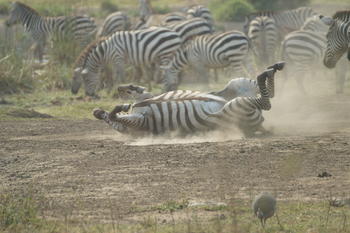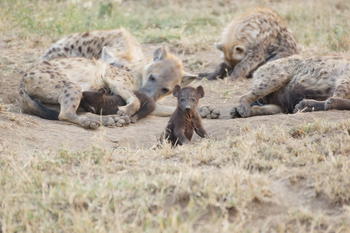Researchers Who Stare at Zebras
Doctoral candidates in veterinary medicine and biology study parasites in wild animals at Serengeti National Park in Tanzania.
Jan 26, 2017
Research at a wildlife park instead of a photo safari: Doctoral candidates from one research training group at Freie Universität spent ten days collecting animal droppings in the Serengeti.
Image Credit: Frank Seeber
The goal of their research is to better understand parasites and how widespread they are.
Image Credit: Ulrich Sternberg
The zebra herd moves unhurriedly across the savanna. One animal lifts its tail. Several pairs of binoculars are now trained on the animal’s striped rear end. The researchers note the location and leave the zebras to move on in peace. Not until they are sure they are not disturbing the herd does the off-road vehicle roll up to where they believe the zebra left its droppings in the tall grass.
Scat is a valuable research material for the doctoral candidates, who are part of Research Training Group 2046, “Parasite Infections: From Experimental Models to Natural Systems,” which is receiving funding from the German Research Foundation (DFG). And scat is just what the eight doctoral candidates who traveled to the Serengeti this past summer collected – lots of it. They took 49 samples in a scant ten days from zebras alone, with many more from spotted hyenas, baboons, and other animals.
Each sample was supplemented with meticulous records of the animal’s age, sex, and rank within the group. Collecting excretions is the only way to take samples from wild animals without contact with the animals themselves. This part of the Serengeti is a national park, and even researchers are subject to strict limitations on how they can interact with nature there.
The fact that the doctoral candidates were able to travel to Tanzania in the first place is due to the efforts of cooperation partners from the Leibniz Institute for Zoo and Wildlife Research (IZW) in Berlin: Heribert Hofer, Director of the IZW, and Marion East, who holds a doctorate in biology. The two of them have been doing research in the Serengeti for decades, and they shared their experiences regarding wild animals and parasites with the students on site in Africa.
Parasites are a major problem all over the world these days. Many become resistant to treatment, and due to global tourism and trade, they spread quickly among both people and animals. In the future, this process could become even faster due to landscape and habitat change and global warming.
With this in mind, the research training group aims to educate the parasitologists of the future. Professor Susanne Hartmann, the director of the institute and coordinator of the group, believes it is essential for her doctoral candidates to learn directly what parasite infections mean to humans and animals. She wants them to forge a link between the biomolecular and immunological questions they study in the lab and the reality “out in the field.” And that sometimes means waiting hours for a zebra to digest.
The Parasitologists of the Future Are Learning in Berlin – and in the Serengeti
Doctoral candidate Christina Bredtmann says the wait was worthwhile. She plans to build a database of nematodes, a type of worms that also infest horses. Analyzing the data should help identify the parasites faster and with greater accuracy in the future. She can now use the parasites found in the zebra droppings to add further detail to her information. She already performed some of her studies of the zebra droppings in the lab at the Serengeti Wildlife Research Centre (SWRC) research station, where she worked in the afternoons.
The doctoral candidates spent their mornings out in the savanna with the researchers from the IZW or local assistants. Oriana Kreutzfeld was happy to be accompanied by the wildlife experts. Kreutzfeld, another doctoral candidate, studied baboons. These primates have long, sharp canine teeth and generally move about in large groups – and they are often infected with parasites similar to malaria.
“There could be genetic reasons why some baboons are susceptible to these pathogens, while others are not,” Kreutzfeld explains. Studying Hepatocystis, a type of parasites that infects monkeys, could help researchers find out whether some humans also have genetic protection against malaria.
To participate in the excursion, which was financed by the German Research Foundation (DFG), applicants had to come up with a research project that tied in with their dissertations and had some relation to wild animals in the Serengeti. Juliane Kofer, who holds a doctorate in biotechnology and now works at the Institute of Immunology at the Department of Veterinary Medicine at Freie Universität Berlin and is the coordinator of the research training group based there, spent nine months preparing for the trip.
In conversation with the researchers, it soon becomes apparent that parasitologists have a somewhat different idea of a dream safari than normal travelers. “It was really impressive to find worm parasites in every single type of animal, from gazelles to rock hyraxes and from zebras to lions,” Hartmann explains.
And while tourists are helplessly at the mercy of the countless tsetse flies, the doctoral candidates summarily decided to use them for a research project. Bredtmann caught the flies in the off-road vehicle, and Kreutzfeld and her colleague Suzana Zakovic prepared them in such a way that their fellow students were able to see the trypanosomes moving in the flies’ intestines.
These parasites trigger various diseases, including sleeping sickness. These experiences made a lasting impression, including on Hartmann herself. She said, “It’s just much more impressive to see the pathogens right on site in a vector that was flying around you in the car just a minute ago than for me to tell the doctoral candidates about the parasites and their molecular particularities back at the university in Berlin, of course.”
Asked whether some of her experiences in Africa came as a shock to her, Bredtmann answers, “No, it was fantastic.” What shocked her were other discoveries. How many animals are run over by off-road vehicles carrying tourists, for example. And the poaching.
One day, she spent hours with the IZW researchers and the station veterinarian, following a hyena that had freed itself from a trap by biting through the clamp holding the wire snare. “The snare, which was still wrapped around its neck, had cut into the windpipe. If we hadn’t found the hyena, it might have been fatal,” she said. Bredtmann talked to locals about the incident, too. “People set traps in the national park because they are poor and don’t have much to eat. That’s something that still gives me plenty to think about.”
Further Information
Professor Dr. Susanne Hartmann, Institute of Immunology, Department of Veterinary Medicine, Freie Universität Berlin, Tel.: +49 30 838 518 24, Email: susanne.hartmann@fu-berlin.de


